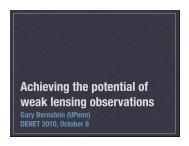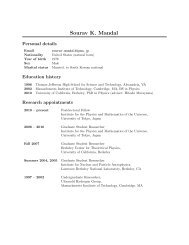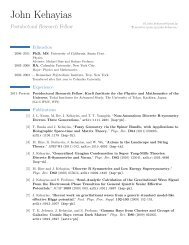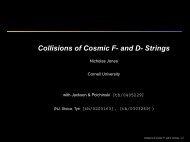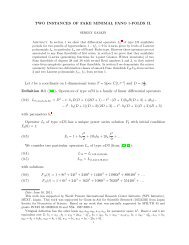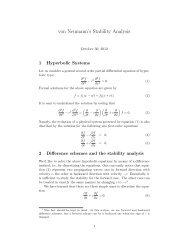STUDY SUMMARY - IPMU
STUDY SUMMARY - IPMU
STUDY SUMMARY - IPMU
You also want an ePaper? Increase the reach of your titles
YUMPU automatically turns print PDFs into web optimized ePapers that Google loves.
<strong>SUMMARY</strong> REPORT<br />
WIDE FIELD FIBER-FED OPTICAL<br />
MULTI-OBJECT SPECTROMETER (WFMOS)<br />
2.4 Galactic Archaeology<br />
2.4.1 Near-Field Cosmology Comes of Age<br />
Understanding the formation and evolution of galaxies remains one of the key questions in<br />
astrophysics. The complex processes that govern growth over cosmic history are imprinted on<br />
the Galactic structure see around us. WFMOS will be the premier instrument in the next decade<br />
capable of connecting a detailed inventory of the Milky Way galaxy and its assembly history<br />
with the rapid progress being made in probing the nature of the Universe on large scales and at<br />
high redshift.<br />
The questions posed by this area of ‘near-field cosmology’ are as fundamental as those posed<br />
in unraveling the mystery of dark energy. What can our Galaxy tell us about the validity of the<br />
standard cosmological model and therefore the nature of dark matter and dark energy on small<br />
scales What role does dark matter play in the assembly history of galaxies and what processes<br />
govern the interaction between dark matter and baryonic gas Are these consistent with predictions<br />
of the standard model of cold, non-interacting dark matter What can the fine structure of<br />
the stellar distribution tell us about the distribution and nature of dark matter itself What was the<br />
sequence and process of formation of the Galaxy and how does our understanding of the history<br />
of the primary sub-components of the Milky Way (bulge, disk and halo and surviving satellites)<br />
influence our picture of how normal galaxies evolved Finally, from studies of neighboring systems,<br />
can we be sure our inferences from the Milky Way are applicable more generally<br />
The key to progress lies in developing a detailed picture of the fossil record of past events,<br />
surveying stars to determine their spatial, kinematic and chemical properties. As galaxies are<br />
dynamically and chemically inhomogeneous, only by using the higher dimensionality afforded<br />
by combining kinematic and chemical measures can a full understanding of their constituent<br />
parts be determined. With its enormous multiplex advantage over an unprecedented wide field,<br />
WFMOS offers unique opportunities in this area. As introduced in the Feasibility Study (FS),<br />
information of two kinds is required. A deep Low-Resolution (LR) survey will chart the structural<br />
composition of the Galaxy using kinematic information and metallicities derived from absorption<br />
line indices. A higher-resolution (HR) survey will use ‘chemical tagging’ to identify<br />
sub-components as well as to unravel their detailed evolutionary history.<br />
A number of developments have occurred in the subject since the FS was published in 2005.<br />
We have taken full account of these, both in defining our science requirements for the instrument<br />
and in fixing our proposed survey parameters. Foremost, we have placed significant emphasis on<br />
synergies with the upcoming Gaia mission; this remarkable satellite will provide parallax and<br />
proper motion information to limits well-matched to those of our WFMOS surveys. The combination<br />
will deliver, for the first time, six-dimensional velocity phase space essential for identifying<br />
galactic components. Secondly, we have taken into account the early progress made in surveying<br />
nearby galaxies, both satellites of the Milky Way and the neighboring M31 and M33<br />
systems. Much work is needed to extend these preliminary investigations that are crucial to determine<br />
whether the conclusions drawn from our Milky Way apply generally to most massive<br />
spirals.<br />
Finally, our team has been directly involved in progress made with Keck’s DEIMOS and<br />
ESO’s FLAMES spectrographs. The latter, in particular, has demonstrated clearly the optimal<br />
resolution for chemo-dynamical fingerprinting as a means to understanding the structure and<br />
evolution of nearby dwarf galaxies. As a result, our technical design and survey strategy have<br />
been significantly streamlined from those proposed in the FS.<br />
12



